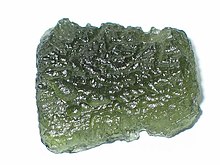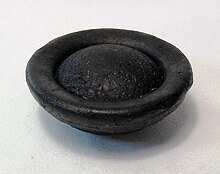Two splash-form tektites, molten terrestrial ejecta from a meteorite impact
Tektites (from Greek τηκτός tēktós, "molten") are gravel-sized bodies composed of black, green, brown, or gray natural glass formed from terrestrial debris ejected during meteorite impacts. The term was coined by Austrian geologist Franz Eduard Suess (1867–1941), son of Eduard Suess. They generally range in size from millimeters to centimeters. Millimeter-scale tektites are known as microtektites.
Tektites are characterized by:
- a fairly homogeneous composition
- an extremely low content of water and other volatiles
- an abundance of lechatelierite
- a general lack of microscopic crystals known as microlites and chemical relation to the local bedrock or local sediments
- their distribution within geographically extensive strewn fields
Characteristics
Although tektites are superficially similar to some terrestrial volcanic glasses (obsidians),
they have unusual distinctive physical characteristics that distinguish
them from such glasses. First, they are completely glassy and lack any
microlites or phenocrysts, unlike terrestrial volcanic glasses. Second, although high in silica (>65 wt%), the bulk chemical and isotopic composition of tektites is closer to those of shales and similar sedimentary rocks
and quite different from the bulk chemical and isotopic composition of
terrestrial volcanic glasses. Third, tektites contain virtually no water
(<0 .02="" a="" and="" are="" bands="" contain="" contains="" few="" finally="" flow-banding="" found="" fourth="" glasses.="" href="https://en.wikipedia.org/wiki/Shocked_quartz" in="" inclusions="" lechatelierite="" melted="" not="" of="" often="" particles="" partly="" tektites="" terrestrial="" the="" title="Shocked quartz" unlike="" volcanic="" which="" within="" wt="">shocked
and unshocked mineral grains, i.e. quartz, apatite, and zircon, as well as coesite.
The difference in water content can be used to distinguish
tektites from terrestrial volcanic glasses. When heated to their melting
point, terrestrial volcanic glasses turn into a foamy glass because of
their content of water and other volatiles. Unlike terrestrial volcanic
glass, a tektite produces only a few bubbles at most when heated to its
melting point, because of its much lower water and other volatiles
content.
Classification
On
the basis of morphology and physical characteristics, tektites have
traditionally been divided into four groups. Those found on land have
traditionally been subdivided into three groups: (1) splash-form
(normal) tektites, (2) aerodynamically shaped tektites, and (3) Muong
Nong-type (layered) tektites. Splash-form and aerodynamically shaped
tektites are only differentiated on the basis of their appearance and
some of their physical characteristics. Splash-form tektites are
centimeter-sized tektites that are shaped like spheres, ellipsoids,
teardrops, dumbbells, and other forms characteristic of isolated molten
bodies. They are regarded as having formed from the solidification of
rotating liquids, and not atmospheric ablation. Aerodynamically shaped
tektites, which are mainly part of the Australasian strewn field, are
splash-form tektites (buttons) which display a secondary ring or flange.
The secondary ring or flange is argued as having been produced during
the high-speed re-entry and ablation of a solidified splash-form tektite
into the atmosphere. Muong Nong tektites are typically larger, greater
than 10 cm in size and 24 kg in weight, irregular, and layered tektites.
They have a chunky, blocky appearance, exhibit a layered structure with
abundant vesicles, and contain mineral inclusions, such as zircon, baddeleyite, chromite, rutile, corundum, cristobalite, and coesite.
Microtektites, the fourth group of tektites, are less than 1 mm
in size. They exhibit a variety of shapes ranging from spherical to
dumbbell, disc, oval, and teardrop. Their colors range from colorless
and transparent to yellowish and pale brown. They frequently contain
bubbles and lechatelierite inclusions. Microtektites are typically found
in deep-sea sediments that are of the same ages as those of the four
known strewn fields.
Microtektites of the Australasian strewn field have also been found on
land within Chinese loess deposits, and in sediment-filled joints and
decimeter-sized weathering pits developed within glacially eroded
granite outcrops of the Victoria Land Transantarctic Mountains,
Antarctica.
A very rare aerodynamically shaped Australite – Shallow Bowl
Occurrence
Since
1963, the majority of known tektites have been known to occur only
within four geographically extensive strewn fields: the Australasian,
Central European, Ivory Coast, and North American. As summarized by Koeberl,
the tektites within each strewn field are related to each other with
respect to the criteria of petrological, physical, and chemical
properties, as well as their age. In addition, three of the four strewn
fields have been clearly linked with impact craters using those same
criteria. Recognized types of tektites, grouped according to their known strewn fields, their associated craters, and ages are:
- Australasian strewnfield (no associated crater identified, age: 0.77–0.78 million years):
- Australites (Australia, dark, mostly black);
- Indochinites (South East Asia, dark, mostly black);
- Philippinites (Philippines, black).
- Central European strewnfield (Nördlinger Ries impact crater (24 km), Germany, age: 15 million years):
- Moldavites (Czech Republic, green).
- Ivory Coast strewnfield (Lake Bosumtwi impact crater (10 km), Ghana, age: 1 million years):
- Ivorites (Ivory Coast, black).
- North American tektite strewn field (Chesapeake Bay impact crater (40 km), United States – age: 34 million years):
- Bediasites (Texas – black to dark brown, some with metallic finish);
- Georgiaites (Georgia – green).
Comparing the number of known impact craters versus the number of
known strewn fields, Artemieva considered essential factors such as the
crater must exceed a certain diameter to produce distal ejecta, and that
the event must be relatively recent. Limiting to diameters 10 km or more and younger than 50 Ma, the study yielded a list of 13 candidate craters, of which the youngest eight are given below:
| Name | Location | Age (million years) |
Diameter (km) |
Strewn field |
|---|---|---|---|---|
| ? | Indochina? | 0.78 | 32–114? | Australasian strewn field |
| Zhamanshin | Kazakhstan | 0.9 ± 0.1 | 14 | ? |
| Bosumtwi | Ghana | 1.07 | 10 | Ivory Coast strewn field |
| Elgygytgyn | Russia, Siberia | 3.5 ± 0.5 | 18 | ? |
| Karakul | Tajikistan | <5 span=""> | 52 | ? |
| Karla | Russia | 5 ± 1 | 10 | ? |
| Ries | Germany | 15.1 ± 0.1 | 24 | Central European strewn field |
| Chesapeake Bay | USA | 35.5 ± 0.3 | 40 | North American strewn field |
| Popigai | Russia, Siberia | 35.7 ± 0.2 | 100 | ? |
Preliminary papers in the late 1970s suggested either Zhamanshin or Elgygytgyn as the source of the Australasian strewnfield.
Povenmire and others have proposed the existence of an additional
tektite strewn field, the Central American strewn field. Evidence for
this reported tektite strewn field consists of tektites recovered from
western Belize in the area of the villages of Bullet Tree Falls, Santa
Familia, and Billy White. This area lies about 55 km east-southeast of
Tikal, where 13 tektites, two of which were dated as being 820,000 years
old, of unknown origin were found. A limited amount of evidence is
interpreted as indicating that the proposed Central American strewn
field likely covers Belize, Honduras, Guatemala, Nicaragua, and possibly
parts of southern Mexico. The hypothesized Pantasma Impact Crater in
northern Nicaragua might be the source of these tektites.
Age
The ages of tektites from the four strewnfields have been determined using radiometric dating methods. The age of moldavites, a type of tektite found in the Czech Republic, was determined to be 14 million years, which agrees well with the age determined for the Nördlinger Ries crater (a few hundred kilometers away in Germany) by radiometric dating of Suevite (an impact breccia
found at the crater). Similar agreements exist between tektites from
the North American strewnfield and the Chesapeake Bay impact crater and
between tektites from the Ivory Coast strewnfield and the Lake Bosumtwi
Crater. Ages of tektites have usually been determined by either the
K-Ar method, fission-track dating, the Ar-Ar technique, or combination
of these techniques.
Origins
Terrestrial source theory
A simple, spherical splash-form Indochinite tektite
The overwhelming consensus of Earth and planetary scientists is that
tektites consist of terrestrial debris that was ejected during the
formation of an impact crater.
During the extreme conditions created by an hypervelocity meteorite
impact, near-surface terrestrial sediments and rocks were either melted,
vaporized, or some combination of these, and ejected from an impact
crater. After ejection from the impact crater, the material formed
millimeter- to centimeter-sized bodies of molten material, which as they
re-entered the atmosphere, rapidly cooled to form tektites that fell to
Earth to create a layer of distal ejecta hundreds or thousands of
kilometers away from the impact site.
A moldavite tektite
The terrestrial source for tektites is supported by well-documented
evidence. The chemical and isotopic composition of tektites indicates
that they are derived from the melting of silica-rich crustal and sedimentary rocks, which are not found on the Moon. In addition, some tektites contain relict mineral inclusions (quartz, zircon, rutile, chromite,
and monazite) that are characteristic of terrestrial sediments and
crustal and sedimentary source rocks. Also, three of the four tektite
strewnfields have been linked by their age and chemical and isotopic
composition to known impact craters. A number of different geochemical
studies of tektites from the Australasian strewnfield concluded that
these tektites consist of melted Jurassic sediments or sedimentary rocks
that were weathered and deposited about 167 My
ago. Their geochemistry suggests that the source of Australasian
tektites is a single sedimentary formation with a narrow range of
stratigraphic ages close to 170 Mya more or less. This effectively
refutes multiple impact hypotheses.
Although the formation of and widespread distribution of tektites
is widely accepted to require the intense (superheated) melting of
near-surface sediments and rocks at the impact site and the following
high-velocity ejection of this material from the impact crater, the
exact processes involved remain poorly understood. One possible
mechanism for the formation of tektites is by the jetting of highly
shocked and superheated melt during the initial contact/compression
stage of impact crater formation. Alternatively, various mechanisms
involving the dispersal of shock-melted material by an expanding vapor
plume, which is created by a hypervelocity impact, have been used to
explain the formation of tektites. Any mechanism by which tektites are
created must explain chemical data that suggest that parent material
from which tektites were created came from near-surface rocks and
sediments at an impact site. In addition, the scarcity of known strewn
fields relative to the number of identified impact craters indicate that
very special and rarely met circumstances are required for tektites to
be created by a meteorite impact.
Nonterrestrial source theories
Aerodynamically shaped australite, the button shape caused by ablation of molten glass in the atmosphere
Though the meteorite impact theory of tektite formation is widely
accepted, there has been considerable controversy about their origin in
the past. As early as 1897, the Dutch geologist Rogier Diederik Marius Verbeek (1845–1926) suggested an extraterrestrial origin for tektites: he proposed that they fell to Earth from the Moon. Verbeek's proposal of an extraterrestrial origin for tektites was soon seconded by the German geologist Franz E. Suess. Subsequently, it was argued that tektites consist of material that was ejected from the Moon
by major hydrogen-driven lunar volcanic eruptions and then drifted
through space to later fall to Earth as tektites. The major proponents
of the lunar origin of tektites include NASA scientist John A. O'Keefe, NASA aerodynamicist Dean R. Chapman, meteorite and tektite collector Darryl Futrell, and long-time tektite researcher Hal Povenmire.
From the 1950s to the 1990s, O'Keefe argued for the lunar origin of
tektites based upon their chemical, i.e. rare-earth, isotopic, and bulk,
composition and physical properties.
Chapman used complex orbital computer models and extensive wind tunnel
tests to argue that the so-called Australasian tektites originated from
the Rosse ejecta ray of the large crater Tycho on the Moon's near side.
O'Keefe, Povenmire, and Futrell claimed on the basis of behavior of
glass melts that the homogenization, which is called "fining", of silica
melts that characterize tektites could not be explained by the
terrestrial-impact theory.
They also argued that the terrestrial-impact theory could not explain
the vesicles and extremely low water and other volatile content of
tektites. Futrell also reported the presence of microscopic internal features within tektites, which argued for a volcanic origin.
At one time, theories advocating the lunar origin of tektites
enjoyed considerable support as part of a spirited controversy about the
origin of tektites that occurred during the 1960s. Starting with the
publication of research concerning lunar samples returned from the Moon,
the consensus of Earth and planetary scientists shifted in favor of
theories advocating a terrestrial impact versus lunar volcanic origin.
For example, one problem with the lunar origin theory is that the
arguments for it that are based upon the behavior of glass melts use
data from pressures and temperatures that are vastly uncharacteristic of
and unrelated to the extreme conditions of hypervelocity impacts.
In addition, various studies have shown that hypervelocity impacts are
likely quite capable of producing low volatile melts with extremely low
water content.
The consensus of Earth and planetary scientists regards the chemical,
i.e. rare-earth, isotopic, and bulk composition evidence as decisively
demonstrating that tektites are derived from terrestrial crustal rock,
i.e. sedimentary rocks, that are unlike any known lunar crust.
In 1960, another nonterrestrial hypothesis for the origin of tektites was proposed by the Russian-born mathematician Matest M. Agrest,
who suggested that tektites were formed as a result of nuclear blasts
produced by extraterrestrial beings. He used this as an argument to
support his paleocontact hypothesis.





